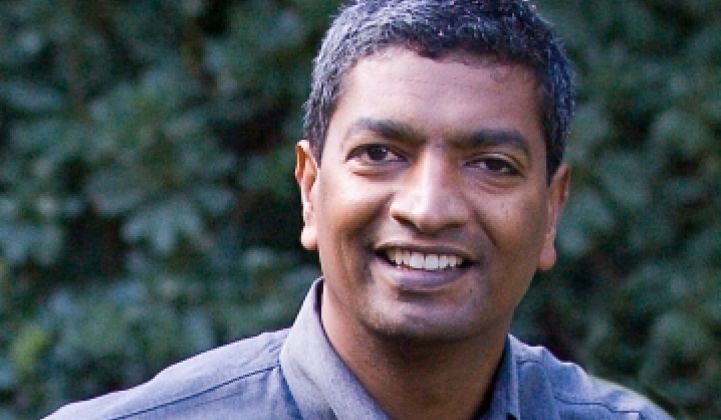By the time they are done, J. Craig Venter of Synthetic Genomics and KR Sridhar of Bloom Energy will have raised more than a billion dollars of venture investment between the two of them. Both of these men are world-class entrepreneurs with world-class investor backing.
They spoke at the Wall Street Journal ECO:nomics event last week. The men are in very different markets with and deal with very different sciences. But both are both taking on enormous technical and societal challenges and huge markets while armed with big war chests -- and big egos. We'll cover Sridhar first.
K.R. Sridhar, the CEO of Bloom Energy, fresh from the peak of the Bloom hype cycle, gave what sounded like a humble Oscar acceptance speech during his time on stage, thanking his investors and employees and saying that he was "just the face of the company." Despite endorsements from 60 Minutes, Colin Powell, Coca Cola, eBay and others, the firm has won nothing yet. They've shipped 30 of their Bloom box units so far and "that's nothing compared to what the world needs." He said, "We have to execute and that burden is on us. We take that responsibility very seriously."
When asked to identify the actual breakthrough that Bloom has made, Sridhar responded, "It's about how you put it together," adding, "We have the advantage of being at the right time and the right place of advances in materials and internet technology."
Sridhar addressed the issue of cost and affordability when confronted with the math of a $750,000 box that generates 100kW. That reads as $7500 per kilowatt -- while competitive cost targets for distributed generation are more in the range of $400 per kilowatt for the system and $100 per kilowatt for the stack.
"That's the wrong way to look at the whole problem," Sridhar responded. "The commodity is not the box, it's the electrons." Sridhar claims that the customer cost of electricity will range from 4 cents per kilowatt hour to 15 cents per kilowatt hour, adding that "the economics for the customer are very simple. The customer can know with certainty and consistency their fuel cost from natural gas or biogas."
He continued: "The economics of the electrons are already there today with subsidies. And we have a pathway and a roadmap that makes us believe that the subsidy can go away."
I spoke with a long-time energy entrepreneur with experience in PPAs for distributed generation. He sees Bloom having a chance if the costs of the unit can be viewed over 20 years rather than five and if maintenance can be minimized.
Google was the first Bloom Box customer and the company's unit has been operating for 19 months. Sridhar claimed that the units have "exceeded every expectation." Sridhar adds that there are "no transmission lines, no transmission losses. Net-net, we will be better than the best power plant. We don't need a grid infrastructure and therefore have a significantly better carbon footprint."
Sridhar emphasized that the fuel cell itself uses no precious metals, employs flat wafer technology and does not need to be fabricated in a clean room. Fabrication of the unit does not take specialized training -- an operator can be trained in three weeks. Sridhar also asserted that there is a Moore's Law of sorts at work in the form of advances in materials.
Illustrating Mr. Sridhar's need for good marketing communications people, Sridhar volunteered that, "Urgency is our middle name. Quality is our last name."
He concluded by saying, "We are not just building a company, we are building an ecosystem -- and building an ecosystem takes time."
We covered the Bloom unveiling here and here. And we brought some perspective to their market challenges here.
Green Kingpins Part 1: KR Sridhar of Bloom Energy
Green Kingpins Part 2: Craig Venter of Synthetic Genomics
Green Kingpins Part 3: John Doerr of KPCB
Green Kingpins Part 4: Vinod Khosla
Green Kingpins Part 5: Paul Holland and the VCs at Foundation Capital



